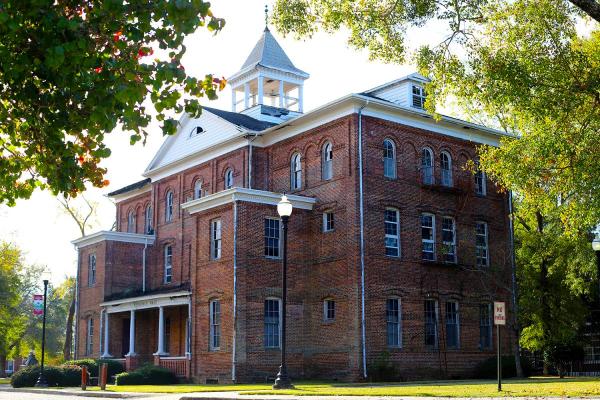Preserving the Legacies of the Nation’s HBCUs

Tuskegee University is one of eight HBCUs to receive a grant through the Historically Black Colleges and Universities Cultural Heritage Stewardship program. Tuskegee will develop a stewardship plan for Thrasher and Sage Halls, designed by noted African American architect Robert R. Taylor.
Photo by Kwesi Daniels, courtesy National Trust for Historic Preservation

Tuskegee University is one of eight HBCUs to receive a grant through the Historically Black Colleges and Universities Cultural Heritage Stewardship program. Tuskegee will develop a stewardship plan for Thrasher and Sage Halls, designed by noted African American architect Robert R. Taylor.
Photo by Kwesi Daniels, courtesy National Trust for Historic Preservation
Across 21 states and jurisdictions, Historically Black Colleges and Universities (HBCUs) educate thousands of students each year and preserve the stories of the generations that came before them. For nearly 200 years, HBCUs have championed education equality and cultivated influential scholars, artists, scientists, and activists, serving as landmarks in their communities and centers of national historic and cultural significance. In 2020, the National Endowment for the Humanities (NEH) partnered with the National Trust for Historic Preservation to strengthen the infrastructural capacity of these important institutions, launching the HBCU Cultural Heritage Stewardship Initiative to protect their enduring legacies and ensure their ability to educate generations to come.
The initiative, created as part of the National Trust’s African American Cultural Heritage Action Fund, provides a combination of funding and support resources, including an expert advisory committee, to develop comprehensive plans that will guide the renovation of historic campus buildings and landscapes, with grants available for campus-wide efforts or individual sites. The first HBCUs to receive stewardship grants were announced in the winter of 2021, with the fund distributing more than $650,000 for projects at eight institutions, including Tuskegee University in Alabama and Morgan State University in Maryland, with an additional round of funding for five HBCUs announced in 2022.
In Denmark, South Carolina, Voorhees University will use grant funds to refurbish portions of its 380-acre campus, which includes 13 buildings constructed between 1905 and 1935 that comprise the Vorhees College Historic District. Founded by Elizabeth Evelyn Wright, Voorhees University has served students since 1897 when it first opened as Denmark Industrial School. The university features many buildings constructed by students and plans to continue this tradition by engaging current students in the restoration process, a key part of the HBCU Cultural Heritage Stewardship Initiative. Each grantee received funding for a student professional development opportunity along with the planning grant, providing paid positions to enable students to work alongside experts and support development of a more diverse network of preservationists. “These historic structures are a source of pride for us and will be used to educate future students who matriculate at our institution,” said Ronnie Hopkins, president of Voorhees University.
Built in 1922 as a dormitory for Stillman College’s first female students, Winsborough Hall is the oldest remaining building at the Tuscaloosa, Alabama, HBCU. Today, Winsborough Hall is central to the college’s efforts to make Stillman a multi-generational campus. Grant funds awarded through the HBCU Cultural Stewardship Initiative will support the building’s restoration and transformation into the Winsborough Living and Learning Center, a residential facility for senior citizens. In addition to restoring the physical structure, Stillman will record oral histories of the building, interviewing former residents from 1970 to 2009, to serve as source materials for students in Stillman’s history department. “We hope that the Winsborough Living & Learning Center will serve as a model for other HBCU campuses, to bridge the generations and enhance student and community participation and education,” said Dr. Cynthia Warrick, president of Stillman College, in an interview with the National Trust.
The third oldest campus in the State University System of Florida, Florida A&M University received a planning grant for a campus-wide project to rehabilitate landmark buildings and document their ties to Black activist and intellectual movements. Development of the preservation plan will engage faculty, staff, and students across disciplines, including humanities scholars, members of the School of Architecture and Engineering Technology, and the experts at the Meek-Eaton Black Archives, Research Center, and Museum. Through this collaborative approach, the university will develop plans that will tell the stories and highlight the impact of Jonathan C. Gibbs, Lucy Moten, and Andrew Carnegie, both at the university and national level, while simultaneously restoring the campus buildings named in their honor. “They also will help preserve the history of the Civil Rights Movement on our campuses where iconic figures like Booker T. Washington, Mary McLeod Bethune, Marian Anderson and others changed American history,” said Larry Robinson, Ph.D., president of Florida A&M University.
To learn more about the HBCU Cultural Heritage Stewardship Initiative and read interviews with faculty and staff from institutions that received funding, visit the National Trust for Historic Preservation website.
HBCU Cultural Heritage Stewardship Initiative Grant Recipients
2021
Benedict College | Columbia, South Carolina
Jackson State University | Jackson, Mississippi
Lane College | Jackson, Tennessee
Morgan State University | Baltimore, Maryland
Philander Smith College | Little Rock, Arkansas
Spelman College | Atlanta, Georgia
Stillman College | Tuscaloosa, Alabama
Tuskegee University | Tuskegee, Alabama
Florida A&M University | Tallahassee, Florida
Rust College | Holly Springs, Mississippi
Johnson C. Smith University | Charlotte, North Carolina
Shaw University | Raleigh, North Carolina
Voorhees University | Denmark, South Carolina